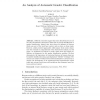Free Online Productivity Tools
i2Speak
i2Symbol
i2OCR
iTex2Img
iWeb2Print
iWeb2Shot
i2Type
iPdf2Split
iPdf2Merge
i2Bopomofo
i2Arabic
i2Style
i2Image
i2PDF
iLatex2Rtf
Sci2ools
CIARP
2007
Springer
2007
Springer
An Analysis of Automatic Gender Classification
Different researches suggest that inner facial features are not the only discriminative features for tasks such as person identification or gender classification. Indeed, they have shown an influence of features which are part of the local face context, such as hair, on these tasks. However, object-centered approaches which ignore local context dominate the research in computational vision based facial analysis. In this paper, we performed an analysis to study which areas and which resolutions are diagnostic for the gender classification problem. We first demonstrate the importance of contextual features in human observers for gender classification using a psychophysical "bubbles" technique. The success rate achieved without internal facial information convinced us to analyze the performance of an appearance-based representation which takes into account facial areas and resolutions that integrate inner features and local context.
| Added | 13 Aug 2010 |
| Updated | 13 Aug 2010 |
| Type | Conference |
| Year | 2007 |
| Where | CIARP |
| Authors | Modesto Castrillón Santana, Quoc C. Vuong |
Comments (0)

